
Bombay Sapphire is a brand of gin that is distilled by the Bombay Spirits Company, a subsidiary company of Bacardi, at Laverstoke Mill in the village of Laverstoke in the English county of Hampshire.
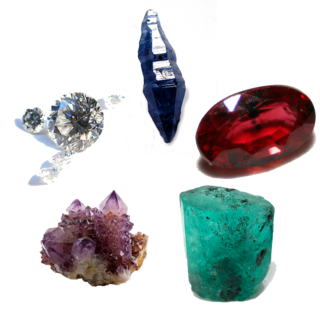
A gemstone is a piece of mineral crystal which, when cut or polished, is used to make jewelry or other adornments. Certain rocks and occasionally organic materials that are not minerals may also be used for jewelry and are therefore often considered to be gemstones as well. Most gemstones are hard, but some softer minerals such as brazilianite may be used in jewelry because of their color or luster or other physical properties that have aesthetic value. However, generally speaking, soft minerals are not typically used as gemstones by virtue of their brittleness and lack of durability.

Sapphire is a precious gemstone, a variety of the mineral corundum, consisting of aluminium oxide (α-Al2O3) with trace amounts of elements such as iron, titanium, cobalt, lead, chromium, vanadium, magnesium, boron, and silicon. The name sapphire is derived from the Latin word sapphirus, itself from the Greek word sappheiros (σάπφειρος), which referred to lapis lazuli. It is typically blue, but natural "fancy" sapphires also occur in yellow, purple, orange, and green colors; "parti sapphires" show two or more colors. Red corundum stones also occur, but are called rubies rather than sapphires. Pink-colored corundum may be classified either as ruby or sapphire depending on the locale. Commonly, natural sapphires are cut and polished into gemstones and worn in jewelry. They also may be created synthetically in laboratories for industrial or decorative purposes in large crystal boules. Because of the remarkable hardness of sapphires – 9 on the Mohs scale (the third hardest mineral, after diamond at 10 and moissanite at 9.5) – sapphires are also used in some non-ornamental applications, such as infrared optical components, high-durability windows, wristwatch crystals and movement bearings, and very thin electronic wafers, which are used as the insulating substrates of special-purpose solid-state electronics such as integrated circuits and GaN-based blue LEDs. Sapphire is the birthstone for September and the gem of the 45th anniversary. A sapphire jubilee occurs after 65 years.

Topaz is a silicate mineral made of aluminum and fluorine with the chemical formula Al2SiO4(F, OH)2. It is used as a gemstone in jewelry and other adornments. Common topaz in its natural state is colorless, though trace element impurities can make it pale blue or golden brown to yellow-orange. Topaz is often treated with heat or radiation to make it a deep blue, reddish-orange, pale green, pink, or purple.

Ruby is a pinkish red to blood-red colored gemstone, a variety of the mineral corundum. Ruby is one of the most popular traditional jewelry gems and is very durable. Other varieties of gem-quality corundum are called sapphires. Ruby is one of the traditional cardinal gems, alongside amethyst, sapphire, emerald, and diamond. The word ruby comes from ruber, Latin for red. The color of a ruby is due to the element chromium.

The mineral or gemstone chrysoberyl is an aluminate of beryllium with the formula BeAl2O4. The name chrysoberyl is derived from the Greek words χρυσός chrysos and βήρυλλος beryllos, meaning "a gold-white spar". Despite the similarity of their names, chrysoberyl and beryl are two completely different gemstones, although they both contain beryllium. Chrysoberyl is the third-hardest frequently encountered natural gemstone and lies at 8.5 on the Mohs scale of mineral hardness, between corundum (9) and topaz (8).
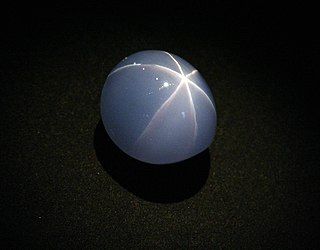
The Star of India is a 563.35-carat star sapphire, one of the largest such gems in the world. It is almost flawless and is unusual in that it has stars on both sides of the stone. The greyish-blue gem was mined in Sri Lanka and is housed in the American Museum of Natural History in New York City.
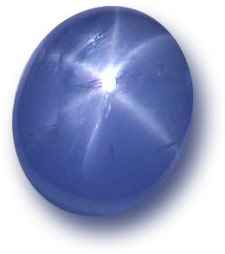
An asterism is a star-shaped concentration of light reflected or refracted from a gemstone. It can appear when a suitable stone is cut en cabochon.

Cordierite (mineralogy) or iolite (gemology) is a magnesium iron aluminium cyclosilicate. Iron is almost always present, and a solid solution exists between Mg-rich cordierite and Fe-rich sekaninaite with a series formula: (Mg,Fe)2Al3(Si5AlO18) to (Fe,Mg)2Al3(Si5AlO18). A high-temperature polymorph exists, indialite, which is isostructural with beryl and has a random distribution of Al in the (Si,Al)6O18 rings. Cordierite is also synthesized and used in high temperature applications such as catalytic converters and pizza stones.
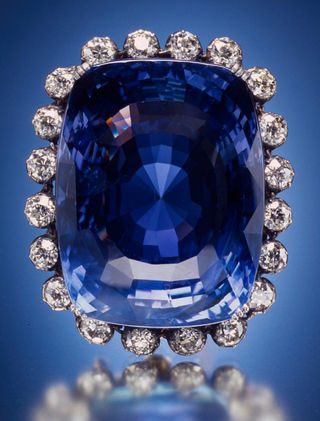
The Logan Sapphire is a 422.98-carat (84.596 g) sapphire from Sri Lanka. One of the largest blue faceted sapphires in the world, it was owned by Sir Victor Sassoon and then purchased by M. Robert Guggenheim as a gift for his wife, Rebecca Pollard Guggenheim, who donated the sapphire to the Smithsonian Institution in 1960. The sapphire's name is derived from Rebecca's new surname after marrying John A. Logan. It has been displayed in the National Gem Collection of the National Museum of Natural History in Washington, D.C., since 1971. It is a mixed cushion-cut sapphire, approximately the size of a large chicken egg, and set in a silver and gold brooch surrounded by 20 round brilliant-cut diamonds.

Sapphire is a saturated shade of blue, referring to the gemstone of the same name. Sapphire gems most commonly occur in a range of blue shades, although they can come in many different colors. Other names for variations of the color sapphire are blue sapphire or sapphire blue, shown below.

The Black Star of Queensland, also known as the Brimstone of Queensland, named after its nature and place of origin, is a 733-carat black sapphire, and was the world's largest gem quality star sapphire until The Star of Adam was discovered.
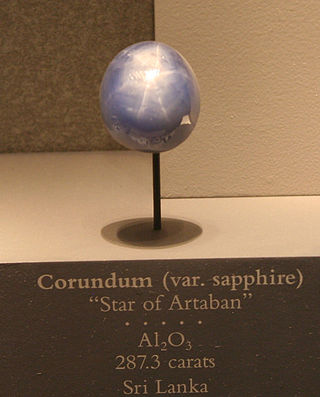
The Star of Artaban is a 287–carat cabochon-cut star sapphire currently located at the Smithsonian National Museum of Natural History. Its origin is somewhat obscure but it is believed to come from Sri Lanka. Unlike some other sapphires, it is not transparent and is of a milky blue colour. It was donated by an anonymous member of the Georgia Mineral Society in the 1941–1943 time period.

The Star of Asia is a large, 330 carats (66 g) cabochon-cut star sapphire now in the Smithsonian National Museum of Natural History. It is noted for its significant size and is considered to be one of the largest of its type. Adding to its aesthetic value are its rich blue colour and clear star, formed from three intersecting rutile striations.

Yogo sapphires are blue sapphires, a colored variety of corundum, found in Montana, primarily in Yogo Gulch in Judith Basin County, Montana. Yogo sapphires are typically cornflower blue, a result of trace amounts of iron and titanium. They have high uniform clarity and maintain their brilliance under artificial light. Because Yogo sapphires occur within a vertically dipping resistive igneous dike, mining efforts have been sporadic and rarely profitable. It is estimated that at least 28 million carats of Yogo sapphires are still in the ground. Jewelry containing Yogo sapphires was given to First Ladies Florence Harding and Bess Truman; in addition, many gems were sold in Europe, though promoters' claims that Yogo sapphires are in the crown jewels of England or the engagement ring of Princess Diana are dubious. Today, several Yogo sapphires are part of the Smithsonian Institution's gem collection.
The Star of Adam is an oval-shaped blue star sapphire, currently the largest star sapphire in the world. It weighs 1,404.49 carats. Prior to its discovery in 2015, the Black Star of Queensland, weighing 733 carats (146.6 g), was the largest star sapphire gem in the world.
The Allison and Roberto Mignone Halls of Gems and Minerals are a series of exhibition halls at the American Museum of Natural History on the Upper West Side in Manhattan, New York City. The halls opened on June 12, 2021, as a complete redesign of their predecessors, the Harry Frank Guggenheim Hall of Gems and Minerals and Morgan Memorial Hall of Gems. The halls feature thousands of rare gems, mineral specimens and pieces of jewelry.















